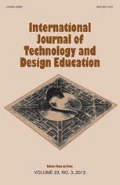Abstract
In New Zealand in order to provide authentic learning experiences teachers are counselled to access Communities of Practice (CoP) (Ministry of Education 2007). This research provides information about teachers’ interactions with CoPs and the implication of this access on their pedagogy. A range of interactions occurred which was influenced by how teachers perceived this use of a CoP representative in their classrooms. These styles of interactions were used by the teachers to create a ‘deep, broad learning experience’ for their students as they developed their technological practice. Two interaction strategies occurred that placed either the CoP in control or the teacher in control. When the teacher was in control four interaction styles occurred with the teacher managing the interaction of the CoP representative. This management allowed the teacher to filter the degree of direct interaction. This research shows that technology teachers’ belief systems affected the pedagogy of the CoP-student interaction.





Similar content being viewed by others
Notes
NCEA: National Certificate of Educational Achievement. The system of secondary school qualifications for students aged 15-18 in New Zealand schools administered by New Zealand Qualifications Authority. See www.nzqa.govt.nz/ncea .
‘Opportune’ refers to an opportunity that presented to the participants, when teachers saw how the CoP representative could be used in their teaching programme. (Slatter and France 2008 ).
References
Brown, J. S., Collins, A., & Duguid, P. (1989). Situated cognition and the culture of learning. Educational Researcher, 18(1), 32–42.
Compton, V., & Harwood, C. (2003). Enhancing technological practice: An assessment framework for technology education in New Zealand. International Journal of Technology and Design Education, 13, 1–26.
Compton, V., & Harwood, C. (2006). Discussion document: Design ideas for future technology programmes. Retrieved December 28, 2006 from http://www.tki.org.nz/r/nzcurriculum/draft-curriculum/technology_e.php.
Head, G., & Dakers, J. (2005). Vérillon’s trio and Wenger’s community: learning in technology education. International Journal of Technology and Design Education, 15, 19–32.
Hill, A. M., & Smith, H. A. (2005). Research in purpose and value for the study of technology education in secondary schools: a theory of authentic learning. International Journal of Technology and Design Education, 15, 33–45.
Hirsch, D. (1992). School and business: A new partnership. France: Organisation for Economic Co-operation and Development.
Jones, A., & Compton, V. (1998). Towards a model for teacher development in technology education: From research to practice. International Journal of Technology and Design Education, 13, 51–65.
Jones, A., & Moreland, J. (2004). Enhancing practicing primary school teachers’ pedagogical content knowledge in technology. International Journal of Technology and Design Education, 14, 121–140.
Lave, J. (1988). Cognition in practice: Mind, mathematics, and culture in everyday life. Cambridge, UK: Cambridge University Press.
Lave, J., & Wenger, E. (1991). Situated learning, Legitimate peripheral participation. Cambridge MA: Cambridge University Press.
McCormick, R. (2004). Issues of learning and knowledge in technology education. International Journal of Technology and Design Education, 14, 21–44.
Ministry of Education. (1995). Technology in the New Zealand curriculum. Wellington: Learning Media.
Ministry of Education (2007). The New Zealand curriculum. Retrieved November 29, 2007 from http://www.minedu.govt.nz.
New Zealand Qualifications Authority (2007). NCEA. Retrieved July 23, 2009 from http://www.nzqa.govt.nz.
Slatter, N. W. (2007). Making technology education real: Accessing a community of practice. Unpublished masters thesis. University of Auckland.
Slatter, W., & France, B. (2008). Accessing the community of practice in technology education. In H. Middleton & M. Pavlova (Eds.), Exploring technology education: Solutions to issues in a globalised world (Vol. 2, pp. 137–146). Surfers Paradise, Queensland, Australia: Griffith Institute for Educational Research.
Turnbull, W. (2002). The place of authenticity in technology in the New Zealand curriculum. International Journal of Technology and Design Education, 12, 23–40.
Vygotsky, L. S. (1987). Thinking and speech. In R. W. Rieber & A. S. Carton (Eds.), The collected works of L.S. Vygotsky, Vol 1, Problems of general psychology. (N. Minick, Trans.). New York: Plenum Press.
Wenger, E. (1998). Communities of practice: Learning, meaning and identity. Cambridge: Cambridge University Press.
Author information
Authors and Affiliations
Corresponding author
Rights and permissions
About this article
Cite this article
Slatter, W., France, B. The teacher–community of practice–student interaction in the New Zealand technology classroom. Int J Technol Des Educ 21, 149–160 (2011). https://doi.org/10.1007/s10798-009-9111-y
Published:
Issue Date:
DOI: https://doi.org/10.1007/s10798-009-9111-y




